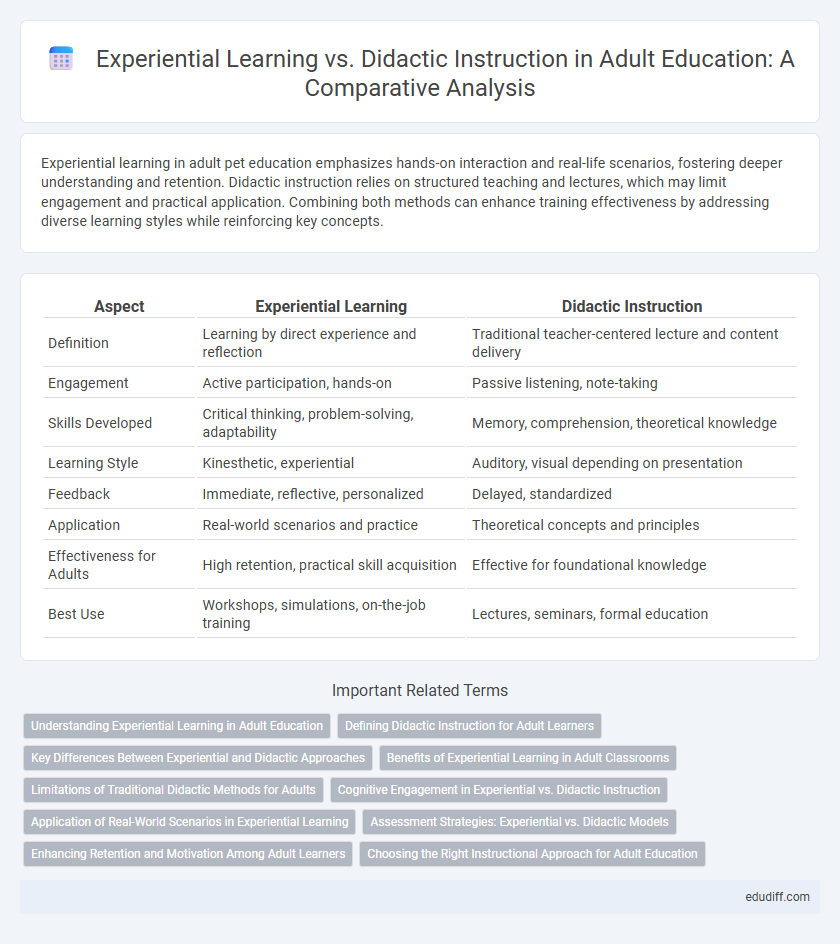Experiential learning in adult pet education emphasizes hands-on interaction and real-life scenarios, fostering deeper understanding and retention. Didactic instruction relies on structured teaching and lectures, which may limit engagement and practical application. Combining both methods can enhance training effectiveness by addressing diverse learning styles while reinforcing key concepts.
Table of Comparison
| Aspect | Experiential Learning | Didactic Instruction |
|---|---|---|
| Definition | Learning by direct experience and reflection | Traditional teacher-centered lecture and content delivery |
| Engagement | Active participation, hands-on | Passive listening, note-taking |
| Skills Developed | Critical thinking, problem-solving, adaptability | Memory, comprehension, theoretical knowledge |
| Learning Style | Kinesthetic, experiential | Auditory, visual depending on presentation |
| Feedback | Immediate, reflective, personalized | Delayed, standardized |
| Application | Real-world scenarios and practice | Theoretical concepts and principles |
| Effectiveness for Adults | High retention, practical skill acquisition | Effective for foundational knowledge |
| Best Use | Workshops, simulations, on-the-job training | Lectures, seminars, formal education |
Understanding Experiential Learning in Adult Education
Experiential learning in adult education emphasizes active participation and real-world application, enabling learners to engage deeply with material through reflection and hands-on experiences. This approach fosters critical thinking, problem-solving, and the ability to transfer knowledge to practical situations, which are essential for adult learners' professional and personal development. By contrasting didactic instruction, which relies on passive information delivery, experiential learning promotes autonomy and intrinsic motivation critical for effective adult education.
Defining Didactic Instruction for Adult Learners
Didactic instruction for adult learners emphasizes structured, teacher-centered delivery of content, prioritizing clear objectives and systematic presentation. This approach relies on lectures, demonstrations, and explicit explanation to convey foundational knowledge and skills efficiently. Adults benefit from didactic methods when seeking precise information or foundational understanding before applying experiential techniques.
Key Differences Between Experiential and Didactic Approaches
Experiential learning emphasizes hands-on activities and real-world experiences that promote active engagement and critical thinking, whereas didactic instruction relies on structured, lecture-based teaching focused on knowledge transmission. Experiential approaches foster deeper understanding through reflection and application, while didactic methods prioritize information delivery and memorization. The key difference lies in learner involvement, with experiential learning encouraging participation and collaboration, contrasting the passive reception typical of didactic instruction.
Benefits of Experiential Learning in Adult Classrooms
Experiential learning in adult classrooms enhances retention and application by engaging learners in hands-on activities that mimic real-world scenarios, fostering deeper understanding and critical thinking skills. This approach promotes active participation, collaboration, and reflection, which are essential for adult learners who bring diverse experiences and prefer practical, relevant content. Studies show that adults retain up to 75% more information when actively involved in learning processes compared to passive didactic instruction.
Limitations of Traditional Didactic Methods for Adults
Traditional didactic methods often limit adult learning by emphasizing passive reception of information rather than active engagement, leading to reduced retention and motivation. Adults benefit more from experiential learning approaches that incorporate practical application, critical thinking, and real-world problem solving. Relying solely on lectures and rote memorization fails to leverage adult learners' prior knowledge and life experiences, hindering the depth and relevance of understanding.
Cognitive Engagement in Experiential vs. Didactic Instruction
Experiential learning significantly enhances cognitive engagement by actively involving adults in real-world problem-solving and critical thinking, which promotes deeper understanding and retention of knowledge. Didactic instruction often results in passive learning, where information is presented without immediate application, reducing opportunities for mental involvement and creativity. Cognitive engagement in experiential settings triggers higher-order thinking skills essential for adult learners to internalize and apply concepts effectively.
Application of Real-World Scenarios in Experiential Learning
Experiential learning emphasizes the application of real-world scenarios to enhance adult education by engaging learners in hands-on experiences that reflect actual challenges and environments. This approach fosters critical thinking, problem-solving, and adaptability, enabling adults to transfer knowledge directly to practical situations. Unlike didactic instruction, which relies on passive information delivery, experiential learning promotes active participation and deeper retention through immersive, context-based activities.
Assessment Strategies: Experiential vs. Didactic Models
Experiential learning assessment prioritizes performance-based evaluations such as simulations, portfolios, and real-world problem-solving tasks that measure practical application and critical thinking. Didactic instruction relies heavily on traditional assessments, including multiple-choice tests, quizzes, and written exams to evaluate knowledge retention and comprehension. The experiential model fosters continuous formative feedback, enhancing skills through reflection, while didactic models emphasize summative assessments for grading and standardized measurement.
Enhancing Retention and Motivation Among Adult Learners
Experiential learning significantly enhances retention and motivation among adult learners by engaging them in hands-on activities that connect theory to real-world practice. Didactic instruction often relies on passive information delivery, which can reduce learner engagement and memory retention over time. Incorporating experiential methods such as simulations, case studies, and collaborative projects fosters deeper understanding and sustained motivation in adult education contexts.
Choosing the Right Instructional Approach for Adult Education
Experiential learning engages adult learners through hands-on activities that promote critical thinking and real-world application, making it ideal for skill development and retention. Didactic instruction delivers structured, theory-based content efficiently, suitable for conveying foundational knowledge or complex information. Selecting the right approach depends on the learning objectives, with experiential methods enhancing practical skills and didactic methods strengthening conceptual understanding in adult education.
Experiential Learning vs Didactic Instruction Infographic

 edudiff.com
edudiff.com